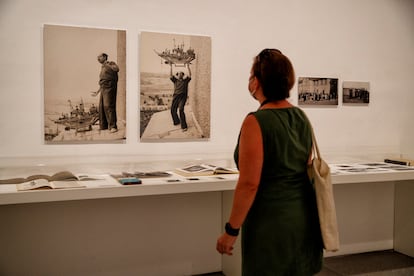It is 1939 and thousands of exiles flee Spain after the fratricidal conflict.
The Civil War is over and there is no other way out.
Many will find death in European concentration camps.
Others sadness, nostalgia and despair.
A few will make virtue of necessity and develop an artistic career whose echoes will allow them to return to their country.
In the homeland they have left, fascism and autarky reign.
This trip to the recent past of the history of Spain makes up
Pensamiento Perdido: Autarquía y Exilio
, the third chapter of the new rethinking of the permanent collection carried out by Manuel Borja-Villel at the head of the Reina Sofía Museum.
More information
PHOTO GALLERY |
A tour of the new rooms
Everything changes place at the Reina Sofía except the 'Guernica'
In 16 rooms, where hundreds of works are exhibited, 60% of which have never been seen in the permanent collection, you look back without losing your eyes on the present.
"The significance and timeliness of the image of the republican exile refers to a historical moment and a fundamental experience not only for Spain and the 20th century, but also for the contemporary 21st century, marked by a global migratory crisis," Rosario explained this Tuesday. Peiró, Head of Collections at the Museum.
The room dedicated to Francesc Tosquelles, a republican psychiatrist who had to take refuge in France, where he became one of the great references of psychiatry in the second half of the 20th century. Claudio Alvarez / EL PAIS
The film
The Exodus of a People
(1939), by the French Louis Llech and Louis Isambert, helps to understand the diaspora of those years. Pablo Picasso's painting
Monument to the Spaniards killed by France
(1946-47) placed next to Robert Capa's photographs of Republican concentration camps such as Argelès-sur-Mer or Bacarés (France, March 1939) becomes in a memory exercise to avoid repeating the same mistakes and in a way of understanding the world in which we live. "It is essential to pay a debt because we know that a country that does not know its own history is condemned to repeat it," said Borja Villel.
“The exiles belonged to one nation, but they were in very different countries.
How do you write a story when your situation is borderline?
Although the country that has welcomed you is not exactly yours, the one you come from will no longer be yours.
A permanent diaspora situation that reminds us of the fields of Palestine or Syria.
It is a contemporary condition ”, stated the director.
Photographs of Robert Capa on the border of Catalonia with France Claudio Alvarez / EL PAIS
The director speaks next to a drawing by Josep Bartolí of the concentration camps. It's made on paper, there was no money for better materials, and it offers a tough look at extreme pain. Next to it is a photo of Lee Miller where those who look at the dead do so almost from the obscenity of coldness. There is also a painting in this area by the Austrian artist Ceija Stojka. It looks like a picture of a girl, up to a point it is. It is the childhood memory of a gypsy woman who at the age of 60 began to draw the horror of her experience in three concentration camps, from which she was saved thanks to her mother hiding her among corpses. He erased his gypsy heritage, his past, until he couldn't take it anymore."She vomits all that history that she had repressed when one of her children died of an overdose and she considers that she could not save him as her mother had done with her," said the director.
The field in these rooms is that of concentration, but also the rural environment.
"During the Franco regime it was an idealized place, the place opposite to the city, sin, crime," Borja-Villel recalled.
"But it is also the symbol of isolation, of the loss of freedom."
Autarky
In the rooms dedicated to autarky, to the initial closure of Francoism until its opening in the fifties, that revisionist discourse so present today sounds in silence. The Spain of silence and prisons, of hunger, of ration cards appears as in the painting
La seamstress
(1943), by José Gutiérrez Solana. Although, as the director of the Reina Sofía explained, “forms of resistance and resilience also appear in a suffocating context”. As an example, Miró's return to Spain in the 1940s. "In a silent way he is capable of creating a school with very young artists such as Tapiès, Cuixart and Saura".
The work 'Forjadores del empio', by Ángel Jalón, from the area dedicated to autarky.
In the background, study for the Cross of the Valley of the Fallen by Francisco de Asís Cabrero. Claudio Alvarez / EL PAIS
The surrealism of Dalí, the humor of the magazine
Quail
and the photography of Santos Yubero have their place in the room
La vanguardia "frivolous" in the postwar period
.
These samples of modernity contrast with the surrealism of Diego de Rivera.
"Mexican surrealism has another language that was not so present in the surrealism that comes from the north, that of the United States or French, it has to do with indigenism," Borja-Villel pointed out.
Your painting
Magnetic fields,
Like the posters that unite Mexico with Germany, it represents another of the ways in which the Museo Reina Sofía tries to tell the history of art from below, from the south, without adhering to the linearity that has excluded several chapters on so many occasions. of history. "It seems that the history of art has evolved from Europe to the United States, but here we see that it evolves from Spain through the Canaries to Mexico and Latin America", has settled.





/cloudfront-eu-central-1.images.arcpublishing.com/prisa/Z2NCG6QSMJBFZF4B5ATHPGYCKI.jpg)


/cloudfront-eu-central-1.images.arcpublishing.com/prisa/OMA4UFCHWBCAJBF6ZSPZWE4ARQ.jpg)
